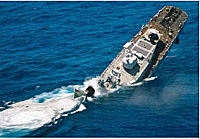 Ex-USS Buchanan Finally Goes Down U.S. Navy photo by Nick Galante
Ex-USS Buchanan Finally Goes Down U.S. Navy photo by Nick Galante
On June 14, 2000, the former USS Buchanan (DDG-14) had a starring role in RIMPAC 2000, as a target in a SINKEX. According to Navy accounts, she was struck by three Hellfire missiles, three Harpoon missiles, and a 2400 lb-laser-guided bomb, but did not sink. She was eventually scuttled with explosive charges.
The question is, as one of my friends asked me, “Why didn’t she sink? Is there something wrong with the damage model in the Trilogy games?”
It’s time to crunch some numbers.
Buchanan (DDG-14) was an Adams-class DDG, commissioned in 1962, and decommissioned in 1991. According to Harpoon’s Annex A, an Adams-class DDG, with a standard displacement of 3350 tons has 103 damage points.
The three weapons used were the AGM-114 Hellfire (9 kg warhead, 2 damage points), the RGM-84 Harpoon (227 kg warhead, 45 damage points), and (probably) the GBU-27 Paveway III (429 kg warhead, 55 damage points).
We can make some assumptions about the exercise. First, it’s safe to assume the weapons were all standard warshots. Second, they probably started with the smaller weapons, and saved the GBU for dessert, since if they did use the big guy first, there might not be a target left for anyone else.
The total damage inflicted was (3 * 2) + (3 * 45) + 55 points = 196 damage points. This is more than enough to put her under, regardless of criticals. Anther safe assumption is that the weapons did not strike the ship simultaneously. While the Harpoons could have been launched in a TOT strike from different platforms, a simultaneous strike complicates data collection, like whose weapons worked and whose didn’t. The others were certainly launched singly.
The Hellfires were pinpricks, simply inflicting their damage and generating a critical hit roll of less than .01.
The Harpoons would generate critical hit rolls on the .7, the .8, and the third one would sink her. Those criticals would have a different effect than in a true combat situation. First, the ship is not in a fight, and is not moving. Her steam plant is not lit off, there is no pressure in her boilers. Sensor, weapon, bridge, rudder, and engineering critical effects can be ignored.
Also, all ordnance had been removed, and for environmental reasons, the ship was defuelled. A lot of flammable material would have been removed during the decommissioning process as well. This means no secondaries, and the risk of fire is much reduced.
Thus, only flooding casualties would have any real effect, and depending on the roll of the “die,” Buchanan’s hull might still be intact. And then there is the GBU. It was the biggest, and packed enough damage to cripple the ship all by itself, and at this point Buchanan should have been under water.
Looking for solutions inside the model, the weapons might have inflicted enough damage to sink Buchanan, but the “sinking roll,” the time taken to actually disappear after inflicting fatal damage, might have been too long. The die roll is 3D6 Tactical Turns, or a maximum of 54 minutes. Were they just impatient to finish the event? Almost certainly not. So the solution lies outside the model. It’s possible that many of the weapons struck in the same spot, effectively “bouncing the rubble.” Harpoon’s damage model assumes an even distribution.
It’s possible the weapons, all striking above the waterline, didn’t create any “flooding criticals.” Damage points are an abstracted measure of hull damage, but if none of the damage is below the waterline, the ship won’t sink.
I’d love to read the SINKEX report, but the Navy doesn’t like to share that kind of stuff. We don’t have an answer, but we wanted you to know we’re paying attention.
BT
Back to The Naval Sitrep #20 Table of Contents
Back to Naval Sitrep List of Issues
Back to MagWeb Master Magazine List
© Copyright 2001 by Larry Bond and Clash of Arms.
This article appears in MagWeb (Magazine Web) on the Internet World Wide Web.
Other military history articles and gaming articles are available at http://www.magweb.com